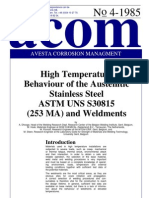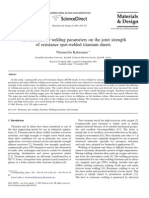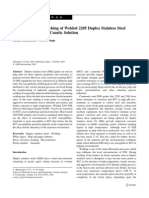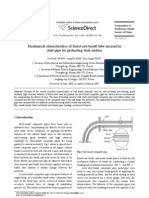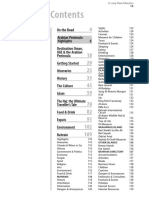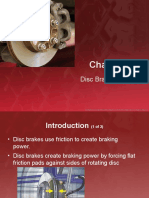Tensile and Fracture Toughness Properties Variation in Inconel 82/182 Dissimilar Metal Welds
Tensile and Fracture Toughness Properties Variation in Inconel 82/182 Dissimilar Metal Welds
Uploaded by
OscarCastilloNavaCopyright:
Available Formats
Tensile and Fracture Toughness Properties Variation in Inconel 82/182 Dissimilar Metal Welds
Tensile and Fracture Toughness Properties Variation in Inconel 82/182 Dissimilar Metal Welds
Uploaded by
OscarCastilloNavaOriginal Description:
Original Title
Copyright
Available Formats
Share this document
Did you find this document useful?
Is this content inappropriate?
Copyright:
Available Formats
Tensile and Fracture Toughness Properties Variation in Inconel 82/182 Dissimilar Metal Welds
Tensile and Fracture Toughness Properties Variation in Inconel 82/182 Dissimilar Metal Welds
Uploaded by
OscarCastilloNavaCopyright:
Available Formats
Transactions of the Korean Nuclear Society Spring Meeting
Jeju, Korea, May 10-11, 2007
Tensile and Fracture Toughness Properties Variation in Inconel 82/182 Dissimilar Metal Welds
Jounghoon Lee,a* Changheui Jang,a Jong Sung Kim,b and Tae Eun Jinb
a. Department of Nuclear and Quantum Engineering, Korea Advanced Institute of Science and Technology
373-1, Guseong-dong, Yuseong-gu, Daejeon, 305-701, Rep. of Korea
*Tel.: +82-42-869-3864, Fax.: +82-42-869-3810, E-mail: jhlee05@kaist.ac.kr
b. Korea Power Engineering Company
360-9 Mabuk-ri, Guseong-eup, Youngin-si, Gyeonggi-do, 449-713, Rep. of Korea
1. Introduction
Dissimilar metal welds between ferritic steel and
austenitic steel tubing and piping are commonly
employed in nuclear power plants. Such transition joints
are necessary because of the corrosion resistance of
stainless steel, while ferritic steels are commercially
more attractive [1]. The concern and interest in the
integrity of dissimilar welds have been raised because of
the incident in V.C. Summer plant [2]. It has been
thought that the repair welding during the construction
caused significant residual stress on the inner surface of
the weld. For the integrity analysis of the dissimilar
welds, it is essential to have enough materials property
database. In this paper, the spatial variations of the
mechanical properties of dissimilar metal weld were
investigated.
2. Test materials and welding
Base materials used to construct dissimilar metal
welds are SA508 Gr.3 low alloy steel and TP316
stainless steel which are the types of material used for
constructing nuclear pressure vessels and pipes in Korea.
These metals are provided as forged and heat treated,
and prepared as 40 mm thick plate before welding
procedure. Using inconel electrode 182 and filler metal
82, dissimilar metal welds are fabricated. These
procedures were followed by manual which is used for
the nozzle to pipe welding in OPR1000. The schematics
of welding procedure are shown in Figure 1.
82/182 weld region, and TP316 stainless steel region
along the welding direction. The specimens were tested
at strain rate of 5x10-4/sec. Test temperature was room
temperature and 320C, and temperature variation of
test was less than 1C. These specimens are made and
tested by ASTM E8M-01.
Figure 2. Locations for round bar tensile specimen.
2.2 Fracture toughness test
Fracture tests were performed on precracked compact
tension (CT) specimens that had a width (W) of 38.1
mm and thickness (B) of 12.7 mm. All specimens had
20 percent side grooves. Inconel weld specimens were
tested in the transverse orientation, with the notch
normal to the welding direction as shown in Figure 3.
Specimens were tested in room temperature and 320C
using direct current potential drop (DCPD) system that
was operated in displacement control. Loading rate for
the test was 0.2 mm/min. Fracture toughness was
followed by ASTM E1737-96 and E1820-05a.
Figure 3. The orientation and position of the specimens.
4. Results and Discussion
Figure 1. Schematics of the dissimilar metal weld of
single V-grooved design.
3. Test method
3.1 Tensile test
Round bar tensile specimens were machined from the
welded plates [3]. As shown in Figure 2, specimens
were taken from SA508 low alloy steel region, inconel
4.1 Tensile Properties
The tensile properties of test materials in air room
temperatures and 320C are summarized in Figure 4.
Test results show a little different property depending
on the test position. In the case of the room temperature,
SA508 Gr.3 base metals show higher yield strength than
inconel 82/182 weld and TP316 base metals. However
UTS values are similar in both of base metals and
Transactions of the Korean Nuclear Society Spring Meeting
Jeju, Korea, May 10-11, 2007
inconel weld metal. Within the weld, a quite large
tensile property variation is present, such that the yield
strength and UTS are larger at the bottom of the weld
than at the top of the weld. In the case of the 320C,
SA508 Gr.3 had the highest value of UTS, and inconel
82/182 has higher values of UTS than those of TP316.
As a whole, the yield strength was decreased as the
temperature was increased at the all materials. The
ultimate tensile strength of SA508 was not changed as
the temperature was increased. However, in the case of
inconel 82/182 and TP316, the ultimate tensile strength
was decreased as the temperature was increased.
(a)
(b)
Figure 4. Tensile properties variation across the
dissimilar metal welds (a) room temp. (b) 320C
4.2 Fracture Toughness
The fracture toughness test results of the inconel
welds are shown in Figure 5. In the case of the room
temperature, for the specimens taken at the same
location, the J-R curves are similar. The J-R curves of
the specimens taken at the top of weld are much greater
than those at the bottom of weld. However, in the case
of the 320C, the J-R curves are not depending on the
location. Because of large number of welding pass and
repeated heat cycles during the welding process, the
mechanical properties can not be uniform within the
weld. Through the fracture surface observation, the
relation between the fracture toughness and fracture
modes can be demonstrated. So the SEM observation is
being observed.
Figure 6. The dominant fracture mechanisms are
different depending on the location within the weld. In
the bottom of the weld (Fig. 6(a)), primary microvoid
coalescences are dominantly observed. In the middle of
the weld (Fig. 6(b)), shear-stretch features are observed
and primary dimples are also partially observed. In the
top of the weld (Fig. 6(c,d)), shear-stretch features are
dominantly observed, and the size of shear-stretch
region are larger than the size in the middle part [4].
Figure 6. Fracture surface morphology for Inconel
82/182 welds
In the case of 320C, the specimens are being
prepared for SEM observation.
5. Conclusion
The dissimilar welds joining the low alloy steel and
stainless steel were fabricated and the spatial variations
in mechanical properties were investigated.
1. Inconel 82/182 weld showed a quite large tensile
property variation. The YS and UTS values are larger at
the bottom of the weld than at the top of the weld. And
these strengths were decreased as the temperature was
increased.
2. At room temperature, fracture toughness at the top
of weld is much higher than at the bottom of weld.
3. Fracture toughness of room temperature was
depending on the ductile fracture modes. The ductile
fracture behavior in inconel 82/182 welds involves a
combination of microvoid coalescence, void-sheet, and
shear-stretch formation.
REFERENCES
(a)
(b)
Figure 5. Fracture toughness variation across the inconel
82/182 welds (a) room temp. (b) 320C
4.3 Fracture Surface Observation
From the fracture surface observation of the compact
tension specimens in the case of the room temperature,
ductile fracture modes are observed. Representative
fracture-surface morphologies of welds are shown in
[1] M. Sireesha, V. Shankar, Shaju K. Albert, S. Sundaresan,
Microstructural features of dissimilar welds between 316LN
austenite steel and alloy 800, Materials science and
Engineering A292, 2000, P74-82.
[2] Crack in Weld Area if Reactor Coolant System Hot Leg
Piping at V.C. Summer, USNRC, IN00-17, October 18 2000.
[3] C. H. Jang, J. H. Lee, S. Y. Jung, J. S. Kim, and T. E. Jin,
Tensile Property Evaluation of Dissimilar Metal Welds
Containing Alloy 82/182 Fusion Weld using Miniature
Specimen., KNS, spring 2006.
[4] W. J. Mills, C. M. Brown, Fracture toughness of alloy
600 and an EN82H weld in Air and Water, Metallurgical and
Materials Transactions A Vol.32A, May, 2001, P1161-1174
You might also like
- Achille Mbembe Out of The Dark Night Essays On DecolonizationDocument276 pagesAchille Mbembe Out of The Dark Night Essays On Decolonizationedifying100% (1)
- Tensile Property Evaluation of Dissimilar Metal Welds Containing Alloy 82/182 Fusion Weld Using Miniature SpecimenDocument2 pagesTensile Property Evaluation of Dissimilar Metal Welds Containing Alloy 82/182 Fusion Weld Using Miniature SpecimenOscar Ruben Castillo NavaNo ratings yet
- 1-S2.0-Flash Butt Welding Application On 16MnCr5 Chain Steel and Investigations of Mechanical Properties-MainDocument9 pages1-S2.0-Flash Butt Welding Application On 16MnCr5 Chain Steel and Investigations of Mechanical Properties-MainHARIMETLYNo ratings yet
- RESEARCH PAPER FinalDocument7 pagesRESEARCH PAPER Final7as1940206No ratings yet
- Titipan ZahraDocument7 pagesTitipan ZahraDikaAfriandiNo ratings yet
- IX 2191 06 Yamazaki Creep Rupture PDFDocument18 pagesIX 2191 06 Yamazaki Creep Rupture PDFIgor GrujićNo ratings yet
- 10-05-2021-1620632819-6-Ijme-5. Ijme - Dissimilar Welding of Ductile Cast Iron To 304 Stainless SteelDocument14 pages10-05-2021-1620632819-6-Ijme-5. Ijme - Dissimilar Welding of Ductile Cast Iron To 304 Stainless Steeliaset123No ratings yet
- 1 s2.0 S2214785319343834 Main PDFDocument6 pages1 s2.0 S2214785319343834 Main PDFJohnny VillarroelNo ratings yet
- Cold Crack Criterion For ADC12 Aluminum Alloy Die CastingDocument6 pagesCold Crack Criterion For ADC12 Aluminum Alloy Die CastingVinodNo ratings yet
- 1Document4 pages1Pawan Kumar SapraNo ratings yet
- Effect of Heat Treatments On The Mechanical Properties of Welded Joints of Alloy Steel by Arc WeldingDocument10 pagesEffect of Heat Treatments On The Mechanical Properties of Welded Joints of Alloy Steel by Arc WeldingFiras RocktNo ratings yet
- IJMTI - Volume 3 - Issue 2 - Pages 10-18Document9 pagesIJMTI - Volume 3 - Issue 2 - Pages 10-18Isaac SimbañaNo ratings yet
- Acom85 - 4 High Temperature Behaviour of The Austenitic SS UNS S30815 (253 MA) & Weldments PDFDocument16 pagesAcom85 - 4 High Temperature Behaviour of The Austenitic SS UNS S30815 (253 MA) & Weldments PDFpipedown456No ratings yet
- A Hot Cracking On Dissimilar Metal Weld Between A106GrB and A312 TP316L With Buttering ERNiCr-3Document16 pagesA Hot Cracking On Dissimilar Metal Weld Between A106GrB and A312 TP316L With Buttering ERNiCr-3kamal touilebNo ratings yet
- 액화수소저장탱크용스테인리스소재의레이저용접적용을위한기초연구Document8 pages액화수소저장탱크용스테인리스소재의레이저용접적용을위한기초연구Sungwook KangNo ratings yet
- A10 Effects of Welding Processes On The Mechanical Properties of HY 80 Steel WeldmentsDocument9 pagesA10 Effects of Welding Processes On The Mechanical Properties of HY 80 Steel WeldmentsXNo ratings yet
- Experimental Investigation of Tensile Properties of Ti-6Al-4V Alloy at Elevated TemperatureDocument5 pagesExperimental Investigation of Tensile Properties of Ti-6Al-4V Alloy at Elevated TemperaturesenthilNo ratings yet
- Investigation Effect of Welding Polarity in Joint Bead Geometry and Mechanical Properties of Shielded Metal Arc Welding ProcessDocument12 pagesInvestigation Effect of Welding Polarity in Joint Bead Geometry and Mechanical Properties of Shielded Metal Arc Welding Processkhairy2013100% (1)
- Fracture Behavior of Heat-A Ected Zone in Low Alloy SteelsDocument8 pagesFracture Behavior of Heat-A Ected Zone in Low Alloy SteelskasoseiNo ratings yet
- Thermal Fields and Residual Stresses Analysis in TIG Weldments of SS 316 and Monel 400 by Numerical Simulation and ExperimentationDocument17 pagesThermal Fields and Residual Stresses Analysis in TIG Weldments of SS 316 and Monel 400 by Numerical Simulation and ExperimentationRami GhorbelNo ratings yet
- Fatigue Cracking of High Pressure Oil TubeDocument8 pagesFatigue Cracking of High Pressure Oil TubeHandrizaHanifAsyrafiNo ratings yet
- Effects of TIG Welding Process On Microstructure, Electrical Resistance and Mechanical Properties of Nichrome 8020Document8 pagesEffects of TIG Welding Process On Microstructure, Electrical Resistance and Mechanical Properties of Nichrome 8020rezaNo ratings yet
- 1 s2.0 S1877705813019097 MainDocument10 pages1 s2.0 S1877705813019097 MainMd MehtabNo ratings yet
- Modeling and Simulation of Welding Temperature FieDocument17 pagesModeling and Simulation of Welding Temperature FieAmrutNo ratings yet
- SDSS 2022 Paper 43 - RevisedDocument6 pagesSDSS 2022 Paper 43 - RevisedBatuhan DerNo ratings yet
- Performance and Analysis of Weld Joint by Using Two Dissimilar Electrodes E6010 and E7018Document5 pagesPerformance and Analysis of Weld Joint by Using Two Dissimilar Electrodes E6010 and E7018Editor IJTSRDNo ratings yet
- 02Document8 pages02Nghiem QuocNo ratings yet
- Heat Input 3Document4 pagesHeat Input 3thomas2019No ratings yet
- NumericalsimulationofS355JR-316LdissimilarmetalweldingDocument14 pagesNumericalsimulationofS355JR-316LdissimilarmetalweldingHamdi HamdiNo ratings yet
- TRAS2017 FullPaper ID01Document4 pagesTRAS2017 FullPaper ID01Kittichai SojiphanNo ratings yet
- Resistance WeldingDocument7 pagesResistance Weldingswaroop_exlncNo ratings yet
- Intergranular Embrittlement of SS 321 Alloy Due To High Temperature CarburizationDocument16 pagesIntergranular Embrittlement of SS 321 Alloy Due To High Temperature CarburizationprasongNo ratings yet
- Microstructure and Mechanical Properties of Friction Stir Welded SAFDocument9 pagesMicrostructure and Mechanical Properties of Friction Stir Welded SAFPPNo ratings yet
- Dylatometria Ferryt DeltaDocument9 pagesDylatometria Ferryt DeltaGrzegorz CiosNo ratings yet
- Materials and Design: I. Hajiannia, M. Shamanian, M. KasiriDocument8 pagesMaterials and Design: I. Hajiannia, M. Shamanian, M. KasiriBurhanuddin As-SirajNo ratings yet
- Demarque 2018Document9 pagesDemarque 2018Jose G. Cueva CardeñaNo ratings yet
- The Influence of Niobium and Aging Treatment in The 18% Ni Maraging SteelDocument8 pagesThe Influence of Niobium and Aging Treatment in The 18% Ni Maraging SteelGopala Rao ThellaputtaNo ratings yet
- The in Uence of Welding Parameters On The Joint Strength of Resistance Spot-Welded Titanium SheetsDocument8 pagesThe in Uence of Welding Parameters On The Joint Strength of Resistance Spot-Welded Titanium Sheetskaliappan45490100% (1)
- Ahmad Zadeh 2011Document15 pagesAhmad Zadeh 2011TapasNo ratings yet
- Thin-Walled Structures: Wei Lu, Pentti M Akel Ainen, Jyri Outinen, Zhongcheng MaDocument8 pagesThin-Walled Structures: Wei Lu, Pentti M Akel Ainen, Jyri Outinen, Zhongcheng MaPiseth HengNo ratings yet
- Interfacial Microstructure and Mechanical Properties of Aluminium Zinc Coated Steel Joints Made by A Modified Metal Inert Gas Welding Brazing Process - 2007 - Materials CharacterizationDocument5 pagesInterfacial Microstructure and Mechanical Properties of Aluminium Zinc Coated Steel Joints Made by A Modified Metal Inert Gas Welding Brazing Process - 2007 - Materials CharacterizationFlorin SapariucNo ratings yet
- Review Paper On Optimization of Metal Inert Gas Welding On Stainless Steel AISI 410by Taguchi MethodDocument8 pagesReview Paper On Optimization of Metal Inert Gas Welding On Stainless Steel AISI 410by Taguchi MethodIJRASETPublicationsNo ratings yet
- RESID. STRESS - Experimental and Numerical Investigations On Residual Stresses in A Multi-Pass Butt-Welded High Strength SM570-TMCPDocument10 pagesRESID. STRESS - Experimental and Numerical Investigations On Residual Stresses in A Multi-Pass Butt-Welded High Strength SM570-TMCPGabriel PaesNo ratings yet
- 2205 SS Crosion Stress CrackDocument7 pages2205 SS Crosion Stress CrackRolando Nuñez MonrroyNo ratings yet
- High-Cycle Fatigue Behavior of Type 316L Stainless SteelDocument9 pagesHigh-Cycle Fatigue Behavior of Type 316L Stainless SteelDeva RajNo ratings yet
- International Journal of Engineering Research and DevelopmentDocument6 pagesInternational Journal of Engineering Research and DevelopmentIJERDNo ratings yet
- Weldability of Cast Iron With Three Electrodes of High Nickel Weldability of Cast Iron With Three Electrodes of High NickelDocument7 pagesWeldability of Cast Iron With Three Electrodes of High Nickel Weldability of Cast Iron With Three Electrodes of High NickelTahsinul Haque TasifNo ratings yet
- E3sconf Icmed2020 01030Document6 pagesE3sconf Icmed2020 01030Isaac SimbañaNo ratings yet
- Schaeffler Diagram PDFDocument16 pagesSchaeffler Diagram PDFrajesh_14No ratings yet
- Schaeffler Diagram PDFDocument16 pagesSchaeffler Diagram PDFrajesh_14No ratings yet
- Mechanical Characteristics of Fused Cast Basalt Tube Encased in Steel Pipe For Protecting Steel SurfaceDocument6 pagesMechanical Characteristics of Fused Cast Basalt Tube Encased in Steel Pipe For Protecting Steel SurfacebelloxNo ratings yet
- Thermal EngineeringDocument5 pagesThermal EngineeringSankar KumarNo ratings yet
- Tensile Properties and Deformation Mechanisms of Nim - 2021 - Materials ScienceDocument10 pagesTensile Properties and Deformation Mechanisms of Nim - 2021 - Materials ScienceAmany KhaledNo ratings yet
- The Influence of Wall Thickness of Hollow Parts On The ThicknessDocument11 pagesThe Influence of Wall Thickness of Hollow Parts On The ThicknessDebopriyo Chakraborty100% (1)
- Microstructure Analysis of Arc Welded Mild Steel Plates: IOP Conference Series: Materials Science and EngineeringDocument7 pagesMicrostructure Analysis of Arc Welded Mild Steel Plates: IOP Conference Series: Materials Science and EngineeringAniekanNo ratings yet
- IAETSD-PREPARATION OF W.P.S FOR STAINLESS STEEL (Ni, CR, Mo, Nu) WELDING PDFDocument3 pagesIAETSD-PREPARATION OF W.P.S FOR STAINLESS STEEL (Ni, CR, Mo, Nu) WELDING PDFiaetsdiaetsd100% (1)
- Combined Meta Forece FactaaDocument6 pagesCombined Meta Forece FactaaAnil Arun JayshreeNo ratings yet
- Microstructure and Failure Behavior 2008Document6 pagesMicrostructure and Failure Behavior 2008Vipin MishraNo ratings yet
- Microstructures and Fatigue Crack Growth of EH36 TMCP Steel WeldmentsDocument8 pagesMicrostructures and Fatigue Crack Growth of EH36 TMCP Steel WeldmentsJohan Esteban Garcia PuentesNo ratings yet
- Optimization of Spheroidized Annealing Process Parameters On AISI 10B21 Steel Wire Using Taguchi ApproachDocument4 pagesOptimization of Spheroidized Annealing Process Parameters On AISI 10B21 Steel Wire Using Taguchi ApproachTanzil ZaidiNo ratings yet
- Mechanical and Microstructural Effects On The Stress Corrosion Cracking of Weld Beads of X-52 and X-70 Pipeline SteelsDocument5 pagesMechanical and Microstructural Effects On The Stress Corrosion Cracking of Weld Beads of X-52 and X-70 Pipeline SteelsOscarCastilloNavaNo ratings yet
- Alloy 827182 Welds PaperDocument21 pagesAlloy 827182 Welds PaperOscarCastilloNavaNo ratings yet
- Corrosion Science: Jongjin Kim, Seung Hyun Kim, Kyung Joon Choi, Chi Bum Bahn, Il Soon Hwang, Ji Hyun KimDocument9 pagesCorrosion Science: Jongjin Kim, Seung Hyun Kim, Kyung Joon Choi, Chi Bum Bahn, Il Soon Hwang, Ji Hyun KimOscarCastilloNavaNo ratings yet
- Stress Corrosion Cracking of Low-Alloy Reactor Pressure Vessel Steels Under Boiling Water Reactor ConditionsDocument18 pagesStress Corrosion Cracking of Low-Alloy Reactor Pressure Vessel Steels Under Boiling Water Reactor ConditionsOscarCastilloNavaNo ratings yet
- Numero 29 Art 36Document9 pagesNumero 29 Art 36OscarCastilloNavaNo ratings yet
- Property Condition Assessment Report ABSTRACT SAMPLE PDFDocument10 pagesProperty Condition Assessment Report ABSTRACT SAMPLE PDFcm100% (1)
- MSDSDocument6 pagesMSDSGökhan UlukuzNo ratings yet
- Refining Processes 2004 PDFDocument293 pagesRefining Processes 2004 PDFramachandran_chem100% (1)
- The Toyota Management System Linking The Seven Key Functional Areas by Monden, YasuhiroDocument253 pagesThe Toyota Management System Linking The Seven Key Functional Areas by Monden, Yasuhirounitans SaigonNo ratings yet
- MR - Nimal Karunarathna CIN-346Document9 pagesMR - Nimal Karunarathna CIN-346ashenjayawardana37No ratings yet
- 2021 LU A Facile Spectroscopic Method For Measuring Lignin Content in Lignocellulosic BiomassDocument7 pages2021 LU A Facile Spectroscopic Method For Measuring Lignin Content in Lignocellulosic BiomassmaczweiNo ratings yet
- Candidate List of SVHC For Authorisation ExportDocument41 pagesCandidate List of SVHC For Authorisation ExportKee SarakarnkosolNo ratings yet
- IELTS Task 2 Question and Introduction ExamplesDocument9 pagesIELTS Task 2 Question and Introduction Examplest macNo ratings yet
- Arac. Zim - ListDocument18 pagesArac. Zim - ListrazambaNo ratings yet
- Raw Material and Basic Material For Chemical IndustriesDocument20 pagesRaw Material and Basic Material For Chemical Industrieslaila nurul qodryNo ratings yet
- Insert Plate DesignDocument8 pagesInsert Plate Designvrajan1988No ratings yet
- Francis Bacon - Critical and Theoretical Perspectives (PDFDrive)Document217 pagesFrancis Bacon - Critical and Theoretical Perspectives (PDFDrive)Markizz10No ratings yet
- Vitamin C For Calcium DepositsDocument5 pagesVitamin C For Calcium DepositsArpanpatelNo ratings yet
- Oman Uae Arabian Pen 2 ContentsDocument5 pagesOman Uae Arabian Pen 2 ContentspeprintoNo ratings yet
- F4E-QA-111 Supplier Risk and Opportunity Management Instruction 29XB3F v1 1Document21 pagesF4E-QA-111 Supplier Risk and Opportunity Management Instruction 29XB3F v1 1SivaNo ratings yet
- Kami Export - Joshua Merri - Table Saw Notes 1Document2 pagesKami Export - Joshua Merri - Table Saw Notes 1api-626535635No ratings yet
- Automatic Valve AP Series Sirca Manual PDFDocument4 pagesAutomatic Valve AP Series Sirca Manual PDFศตวรรษ ฉิมวัยNo ratings yet
- Membaca - The Lost PrincessDocument4 pagesMembaca - The Lost PrincesskunciNo ratings yet
- A Series PBX Operate ManualDocument71 pagesA Series PBX Operate ManualArokiaraj RajNo ratings yet
- Differential Diagnosis Pain Right HypochondriumDocument35 pagesDifferential Diagnosis Pain Right HypochondriumDrArish Mahmood100% (1)
- A320 SimsDocument198 pagesA320 SimsHarris Shaikh100% (3)
- BTG Pulp & Paper Sensors AB VBW-1100 Electronics Wall Mounted A0122382Document1 pageBTG Pulp & Paper Sensors AB VBW-1100 Electronics Wall Mounted A0122382Hector HerreraNo ratings yet
- Additional Acessories - CP30 Scraper VersionDocument237 pagesAdditional Acessories - CP30 Scraper VersionSunny SethiNo ratings yet
- All About Air Quality PosterDocument1 pageAll About Air Quality PosterEstebanNo ratings yet
- Olanzapine Drug StudyDocument5 pagesOlanzapine Drug Studyjohnlester_jlfNo ratings yet
- Seeding Square Spare Parts - Includes The Measuring Wand With Attached Seed Scooping Spoon, Seed Funnel, Instructions and PlantiDocument1 pageSeeding Square Spare Parts - Includes The Measuring Wand With Attached Seed Scooping Spoon, Seed Funnel, Instructions and Plantik727gppq7fNo ratings yet
- Presentation 1Document61 pagesPresentation 1ahmad rizalNo ratings yet
- Who We Are?: The ConceptDocument2 pagesWho We Are?: The Conceptbookworm12045No ratings yet
- United States Patent: (10) Patent No.: US 6,974,554 B2Document8 pagesUnited States Patent: (10) Patent No.: US 6,974,554 B2Vansala GanesanNo ratings yet












